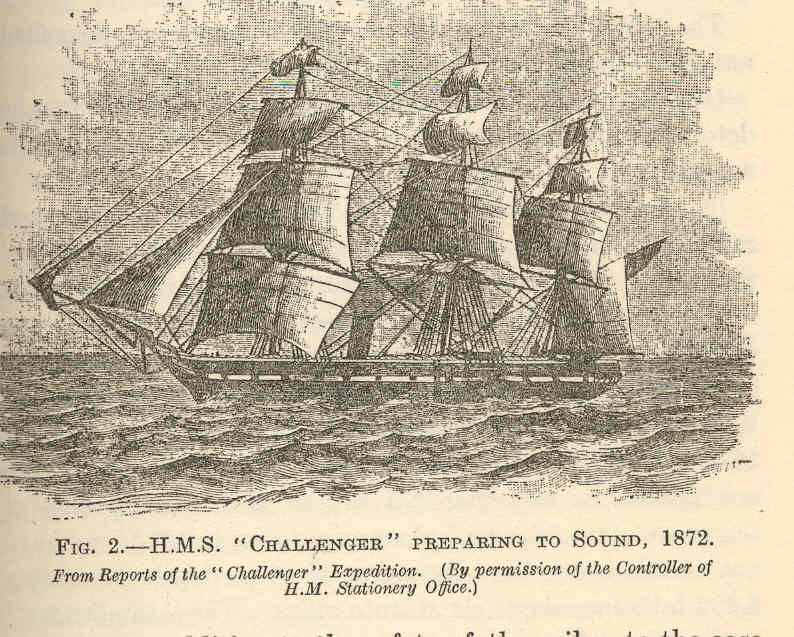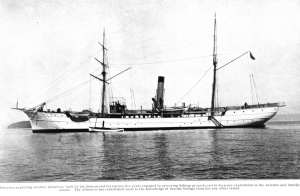2.1 Early Ocean Exploration
When did the first scientific investigations of our oceans begin? We can look to Endurance, Endeavour, Fram, and H.M.S. Beagle. These are names of just a few of the historic ships that sailed scientists and explored regions across the globe to expand our knowledge of oceanography. This chapter highlights a few of these notable vessels and the contributions from those that sailed on board.
H.M.S. Challenger

Launched in 1858, H.M.S. Challenger was a small warship with cannons assigned to coastal patrols and to support larger ships in the British naval fleet – it was not built for a science expedition. Modifications to Challenger were funded by the British government through the navy to include laboratories and accommodations for six civilian scientists to join the 250 British Royal Navy sailors and officers for the 3+ year journey at sea. Although there were several ships that went out on scientific expeditions prior to 1872, the Challenger expedition is the one credited as giving rise to the field of oceanography – in fact, before 1872, the term “oceanography” didn’t even exist in any dictionaries.
John Buchanan, one of the six scientists aboard Challenger and the only physical scientist (a chemist), claimed that oceanography was born “the day the first official observing station of the expedition was occupied, in the Atlantic Ocean west of the island of Tenerife” (Macdougall, 2019, p. xiii). John Murray, another scientist (naturalist) on board, is credited with coining the actual term oceanography (p. 29).
The Royal Society appointed a Circumnavigation Committee , charging these scientists with the task to set out Challenger’s course and activities. The Committee defined the details for “why” and “how” Challenger should determine the physical, chemical, and biological characteristics of the global ocean, emphasizing the deep sea (report available online). H.M.S. Challenger’s mission was all about collecting samples, whether those samples be seafloor mud, manganese modules, corals, crabs, and plant and animal life from the islands they visited over their three-year journey. The scientists focused on gathering as many samples as possible, then examining, describing, and cataloging what they found.
The six scientists on board Challenger were not concerned about aquatic systems or human/environment interactions – this really was a journey of discovery and documenting what exists in these unexplored areas. This is the way natural science was carried out at this time in history. Upon conclusion of the expedition, it took 50 volumes of the Challenger Report to share what was seen and collected – including roughly 4,700 new plant and animal species.
Other Ships
Meteor
The H.M.S. Challenger was known for grab samples of ocean sediments and more from the seafloor, which provided a snapshot of the present but not the past history of the ocean. From its Atlantic Ocean expedition 1925-1927, the German ship Meteor collected some of the earliest types of cores. These meter-long gravity cores collected layers of ocean sediment through a hollow tube hooked on one end and that was lowered into the ocean. When pulled back on to the ship, the record of deposition over time was available for sedimentologists and micropaleontologists to examine and to make some early discoveries in the field of paleoceanography.
In addition to its coring activities, Meteor was known for collecting depth soundings. Although the echo sounder was invented in 1912, the Meteor was the first ship to use this early sonar equipment for scientific objectives. Again during its 1925-1927 expedition, Meteor sailed back-and-forth across the South Atlantic Ocean and collected 67,000 echo soundings while sailing over 67,000 nautical miles along east-west transects. This detailed survey was the first for the South Atlantic Ocean and showed scientists that the Mid-Atlantic Ridge extended throughout the South Atlantic and continued into the Indian Ocean. These data allowed cartographers to plot an oceanographic depth chart.
For those interested in learning more about the evolution of sounding instruments, NOAA has a transcript of a talk given in 1932 by Dr. Herbert Grove Dorsey, then the chief of the Coast and Geodetic Survey Radiosonic Laboratory. Visit: Echoes Gives Ocean Depths: A Radio Talk (*photos of the early equipment is included on this web page)
Image 1: The Meteor (ship) of the German Meteor expedition (Credit: Wikimedia Commons). Image 2: Original plan for the German Meteor Expedition 1925-1927 (Credit: Wikimedia Commons).
Albatross

Built in 1882, the steamer Albatross was the first U.S. vessel designed explicitly for oceanographic research. It is also the first vessel built for marine research by any government, in this case for the United States Commission of Fish and Fisheries. The ship was equipped with electric lights on the ship and for use under water, another first in the U.S. fleet. Albatross sailed primarily in the Atlantic Ocean but also traveled to the Bering Sea, archipelagoes of the Pacific Ocean, and served in two wars. Albatross conducted hydrographic surveys and dredging seafloor material until 1920, and the ship was decommissioned in 1921.
For those interested in learning more about Albatross, visit: R/V Albatross I, 1882-1921.
Exercise: An Early International Oceanographic Collaboration
As you see from the ships presented on this page, oceanographic research was driven by individual nations on ships of their own construction. We know that in the present, especially when it comes to the scientific ocean drilling community, we have one global ocean that is studied by scientists from across all nations. But international collaboration for ocean exploration began earlier than many people realize. Take a moment and read through this article from Limnology and Oceanography Bulletin, titled An Early Example of International Oceanography: The Last Voyage of the Carnegie (1928–1929).
a) List the nations that Cruise VII of Carnegie collaborated with and/or visited.
b) What was focus of some of the oceanographic research carried out by Carnegie?
c) In your opinion, how does the discipline of oceanography benefit from international collaboration?
[H.M.S. Challenger summary is from L. Guertin’s AGU blog post, The missions of H.M.S. Challenger and JOIDES Resolution – a comparison of ocean exploration then and now (March 18, 2022)]

